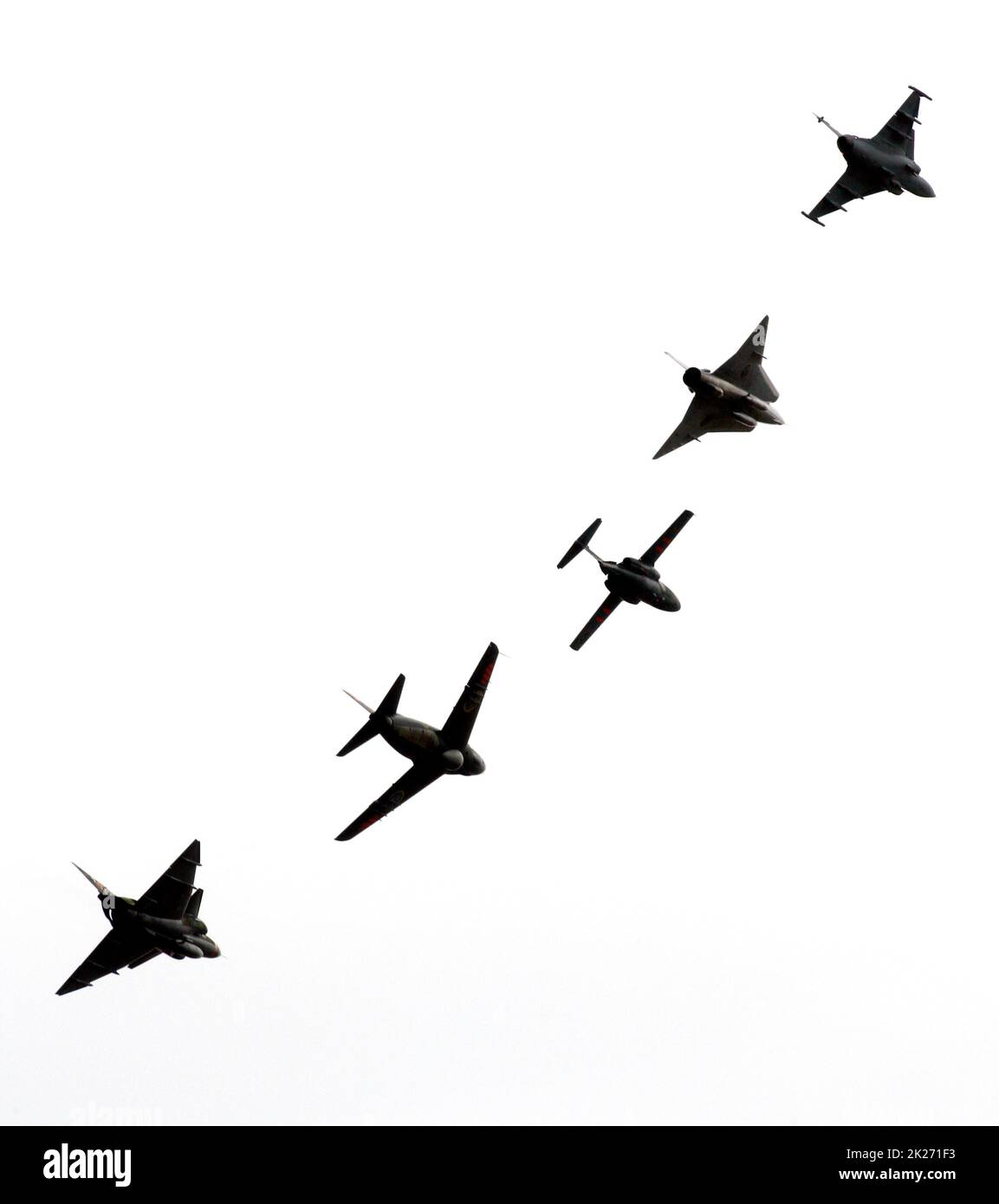Jas 37 Viggen - Is a Swedish single-seat, single-engine, short-range fighter aircraft. Development work on this type began at Saab in 1952 and, after choosing a delta power wing configuration, the resulting aircraft flew on 8 February 1967 and entered service on 21 June 1971. It was the first mass-produced canard design .
Fighter in Europe, although slower than the earlier MiG-21bis, until the entry into service of the Panavia Tornado in 1981.
Jas 37 Viggen

Several different types of Vigg were produced to fulfill the role of strike fighter (AJ 37), early warning aircraft (SF 37), maritime patrol aircraft (SH 37) and two-seat trainer (Sk 37). In the late 1970s, the JA 37 all-weather fighter was introduced. In November 2005, the Vigg was retired by the Swedish Air Force, the sole operator, replaced by the new Saab JAS 39 Grip.
Saab 37 Viggen Scale Models
The first meaning refers to åskvigg, which in modern times is translated as "thunder". However, traditionally the word means "thunderstones", prehistoric stone axes found in the ground in the Viking Age ("åsk-vigg" = "thunder wedge"). Modern Scandinavians thought that these axes were destroyed by the thunderbolt of the god Thor when he hunted giants with his war hammer called Mjölnir.
These axes were believed to have magical powers such as protection from lightning (since "lightning never strikes the same place twice"). However, over time this word was changed to the Swedish equivalent of the bright "thunder", so the name means that. However, since the name Vigg does not have the "thunder" prefix åsk and is clearly Swedish, it should be translated as "Bolt" when referring to this meaning.
The second meaning refers to vigg, the Swedish word for tufted duck. It refers to its canard configuration as "canard" is Frch for duck.
The Vigg was originally developed as an intended replacement for the Saab 32 Lans in an attack role and later the Saab 35 Drak as a fighter.
Saab 37 Viggen Blueprint
In 1955, when Saab's prototype Drak, then the most advanced fighter in the world, made its first flight, the Swedish Air Force was already setting a series of requirements for the next generation of fighters; due to the challenge of these requirements, a short development period was anticipated, with the first aircraft expected to be available before the middle of the next decade.
Between 1952 and 1957, the first studies were carried out on what would become the Vigg, that includes Finnish aircraft designer Aarne Lakomaa. More than 100 different concepts were investigated in these studies, including single and double gin configurations, traditional and double delta wings, and canard wings. Ev VTOL designs were considered, with separate elevator engines, but were soon found to be unacceptable.
From the beginning, the Vigg was planned as an integrated weapon system, to be used with a new modification of Sweden's national air defense system, the STRIL-60. It was used as a standard platform for the country, which could be adapted to fulfill all mission tasks.

Other requirements include supersonic capability at low altitude, Mach2 performance at altitude, and the ability to land short at low angles of attack (to avoid damaging the developed flight paths). The aircraft was also designed from the start to be easy to repair and service, eg for operators without much training.
File:saab Sf 37 Viggen 37954 001.jpg
Another critical requirement of the proposed aircraft was the ability to operate from short runways of only 500 meters; it was part of the Bas 60 air system introduced by the Swedish Air Force in the late 1950s. Bas 60 was around the distribution of aircraft over many airspaces during the war, including the runways that served as runways for the aircraft.
The use of partially destroyed runways was another factor affecting STOL capabilities. Bas 60 was developed into Bas 90 in the 1970s and 1980s, and included only short routes of 800 meters in latitude.
Carrying out such an operation placed several important demands on the design, including a moderate landing speed, a non-flammable glide, a strong landing, maneuverability accuracy when the wind crosses the ice, and high speed when taking off .
In 1960, the US National Security Council, headed by President Eishower, made a security guarantee for Sweden and promised US military assistance in the event of a Soviet attack against Sweden; both countries signed a military and technological agreement. In what was known as the "37 Annex", Sweden was allowed access to advanced American aircraft technology that allowed the Vigg to be designed and manufactured faster and cheaper than when possible.
Saab S37 Viggen
According to research by Nils Bruzelius of the Swedish National Defense College, the reason for this unknown US support was to protect US submarines. Polaris deployed off the east coast of Sweden against the threat of Soviet anti-submarine aircraft.
The connection also seems questionable due to the time scale - the Vigg strike version entered service in 1971, and the fighter version in 1978, when Polaris had already been retired.
In December 1961, the Swedish government gave permission for the development of the Aircraft System 37, which would eventually become the Vigg.

By 1962, all aspects of the project were in place or close to being fully developed; this included the aircraft itself, the power plant, the ejection seat, arms, test equipment, ground handling equipment and training equipment such as simulators.
My Favourite Aeroplane In 200 Words #24 Saab 37 Viggen By Alice Dryden
General planning permission was granted in February 1962, followed by a development contract in October 1962.
According to aviation writers Bill Gunston and Peter Gilchrist, the project was "the largest industrial development project ever attempted in Sweden".
In 1963, Saab completed the design of the aircraft; the aerodynamic configuration was very powerful: it combined a double delta wing with a small, high-mounted canard wing, with powered wings on the front and top of the wing and main; it would be considered the best way to meet the conflicting requirements of STOL operation, supersonic speed, low turbulence in low-flying flight, and increased efficiency for subsonic flight.
Canards are now common in fighter aircraft, particularly with the Eurofighter Typhoon, Dassault Rafale, Saab JAS 39 Grip and IAI Kfir, but mainly for the purpose of providing in-flight capability rather than capability.
Database: Saab 37 Viggen Insights
Other aerodynamic improvements during the later stages of development included the addition of houndstooth patterns on the main wing to generate waves, allowing the elimination of flared wings within the canard. The use of a thrust reverser facilitated short sliding operations.
During development, Saab chose to power the model with a single large turbofan. Initially, the British gin machine Rolls-Royce Medway was chosen to use Vigg, which was considered suitable for the basis of a powerful vine with a completely modified burner; However, development of the Medway engine was canceled due to the initial aircraft, the de Havilland Tridt, being cut short during development.
At Medway, Saab chose instead to adopt a license production version of the American Pratt & Whitney JT8D engine, the Volvo RM8. The RM8 has been redesigned using new materials to accommodate Mach-2 flight, a Swedish-built rear intake and a fully adjustable nozzle.

In 1964, construction of the first prototype aircraft began; on February 8, 1967, the first of seven prototypes flew its mission, which occurred according to the established development schedule.
Aj 37 Viggen \
This first flight, which lasted 43 minutes, was conducted by Erik Dahlström, Saab's chief test pilot, who reported that the prototype was easy to handle throughout. Writing at the time, Flight International magazine described the aircraft as "a unique Swedish invention at the forefront of advanced aircraft-building countries..."
Each of the seven prototypes was assigned different tasks, although the first aircraft was focused on supporting the development of the first production model, the AJ37.
In 1967, the Swedish government decided that the AJ 37 Vigg would be cheaper to develop than the McDonnell Douglas F-4 Phantom II.
In April 1968, the Swedish government gave Vigg the go-ahead and placed an order for 175 Viggs that year.
Thanks To Its Unique Thrust Reverser The Saab 37 Viggen Could Land, Come To A Full Stop, Perform A Y Turn On The Runway And Take Off In The Opposite Direction
In May 1969, the Vigg made its first appearance outside of Sweden at the Paris Air Show.
While the first AJ 37 Vigg was produced for service, other Vigg models continued to enter production and later production.
In 1972, the first SK 37, a performance trainer type with a dramatic second canopy for the instructor, was delivered to the Swedish Air Force.

On May 21, 1973, the first prototype of the SF 37 Vigg, a scientific warning type with a modified nose to accommodate sev ssors, flew for the first time.
Watch The Iconic Sk 37e Viggen Landing, Reversing, And Taking Off In The Opposite Direction While Performing At Zigermeet 2019 Airshow
Although other models went into production in the 1960s, Saab continued with the development of an all-weather aircraft model, the JA 37. In 1970, these Swedish air forms were carefully evaluated, and it was decided that the JA 37 Vigg. it was very suitable for the part.
About
Saab 37 viggen for sale, saab viggen 37, saab ja 37 viggen, jas 37 gripen, saab j 37 viggen, jas viggen, j 37 viggen, saab ajs 37 viggen, 37 viggen, sh 37 viggen, viggen, saab jas 37 viggen
0 Comments